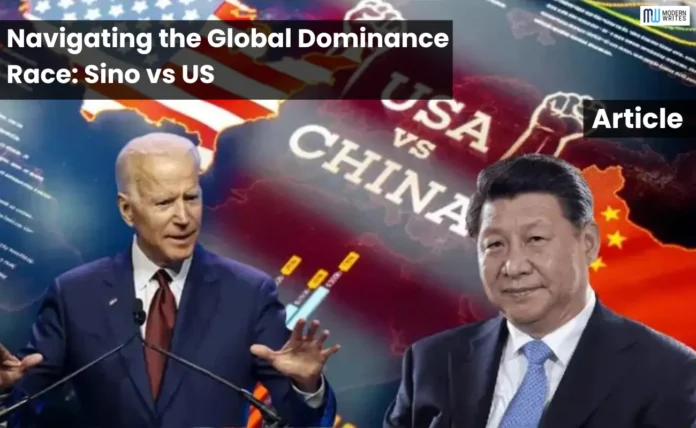In the 21st century, the USA and China are having a massive geopolitical confrontation. These two superpowers compete with one another for a position on the international stage. And it is necessary to have a solid understanding of the dynamics of this competition and the potential repercussions it could have.
The purpose of this article is to investigate the origins, manifestations, and ramifications of the global dominance race between China and the United States. It does so by delving into the many facets of the global dominance race.
Cybersecurity and Information Warfare
The USA, like China, has mastered the art of cyber dominance, but cyberattacks have interfered. The dissemination of rumors, not to mention spying efforts, has become an integral part of the covert operations. To achieve this, the conduct of offensive cyber operations and the enhancement of the cybersecurity infrastructure of the nation are very important for the nation in this cyber war. Global Dominance Race
Resource competition and energy security
The search for natural resources and power is becoming increasingly intense. The Americans and the Chinese are actively searching for potential sources of critical minerals and oil reserves. Competition for resource-rich areas, including the Arctic and Africa, draws attention to the geopolitical significance of energy diplomacy and safe resource extraction and management.
The end of the Cold War marked the beginning of the competition between the United States and China. As the United States became the sole superpower, it possessed unparalleled power and dominance. This is when the rivalry between the two countries began. China’s rapid economic ascent, however, has thrown this unipolar system into disarray. Market reforms and globalization have fueled this.
The confluence of China’s economic prowess and its geopolitical ambitions under the leadership of the Chinese Communist Party has set up a competition of power and influence between Sino vs. US for global dominance. Global Dominance Race
-
There is a tremendous economic competition in the global dominance race: Sino vs. US, which is at the core of the rivalry between the two countries. China has rapidly risen to become the world’s second-largest economy. This presents a direct challenge to the economic hegemony of the United States.
-
The trade war exposed tensions related to trade imbalances, intellectual property theft, and market access. The Donald Trump administration initiated the trade war.
-
Furthermore, China’s Belt and Road Initiative (BRI) aims to spread its economic footprints across the globe. Frequently, it expands into countries traditionally considered under the United States’ sphere of influence.
-
China and the United States are fiercely competing on several fronts. The technology and economy race, for example, represents a battleground for technical supremacy.
-
The goal of the Made in China 2025 project is to obtain a dominant position in important technologies. This includes quantum computing, artificial intelligence, and fifth-generation wireless networks.
-
The United States of America has responded to the strategic implications of technical leadership by implementing initiatives like the National Quantum Initiative and imposing limitations on Chinese technology businesses such as Huawei and TikTok.
In addition to reshaping the economic landscape, the conclusion of this technology race will also determine the military’s capabilities and the extent of their influence on the world stage. Global Dominance Race
The global dominance race of Sino vs. US both advocates for peaceful coexistence; nonetheless, military posturing in the Indo-Pacific region shows underlying geopolitical tensions. This is despite the fact that both countries are in favor of peaceful coexistence. China’s assertiveness in the region, as demonstrated by the construction of islands and maritime patrols, is challenging the United States’ naval superiority in the South China Sea.
As a result, the United States has increased its military presence by conducting freedom of navigation operations. The United States has also established relationships with neighboring nations like Japan and Australia. Despite the fact that there is a significant possibility of unintentional escalation, there are still concerns about violence in this strategically important region. Global Dominance Race
The race for global dominance in the Sino-US ideological rivalry is ongoing Global Dominance Race
The global dominance race of Sino vs. US extends beyond the realms of economics and military might, and it also has an ideological dimension. The United States of America advocates liberal democratic values, which contrast with China’s authoritarian capitalism, which is characterized by state intervention in the economy and strict control over political dissent.
When it comes to issues such as human rights, censorship, and governance of developing technologies, The contrast between these ideologies is increasingly evident. Furthermore, in addition to having the potential to influence domestic governance, the outcome of this ideological conflict may also influence the future course of global norms and institutions.
Implications for the International Order Global Dominance Race
The outcome of the Sino-US dominance race to establish global supremacy will have significant repercussions for the world’s existing order. It is possible that the global power dynamics may change. If China were to achieve a level of success that surpasses that of the United States in the areas of economics, technology, or military,
One possible outcome of this scenario is a transition toward a multipolar world order, in which China plays a more significant role. The sustained dominance of the United States, on the other hand, may serve to strengthen the existing liberal international order, albeit with modifications to account for the development of China.
As the global dominance race between China and the US continues to develop, It is necessary to strike a delicate balance between collaboration and competition in order to successfully navigate the route forward. While it is unavoidable that rivalry will occur, particularly in areas of strategic relevance, both parties must acknowledge the necessity of working together to address issues of global significance. These issues include climate change, the response to pandemics, and the prevention of nuclear proliferation.
Through dialogue, diplomacy, and multilateral organizations, constructive engagement can control tensions and lower the likelihood of conflict. One of the most distinguishing features of the 21st century geopolitical environment is the current competition between China and the United States for global dominance.
The stakes are high and the repercussions are far-reaching as these two nations compete for supremacy in a variety of fields, including economics, technology, the military, and ideology. In order to successfully navigate this competition, one must possess strategic foresight, demonstrate smart diplomacy, and demonstrate a commitment to maintaining the consistency and prosperity of the international order. At the end of the day, the way in which this competition develops will determine the path that history takes for future generations. Global Dominance Race





